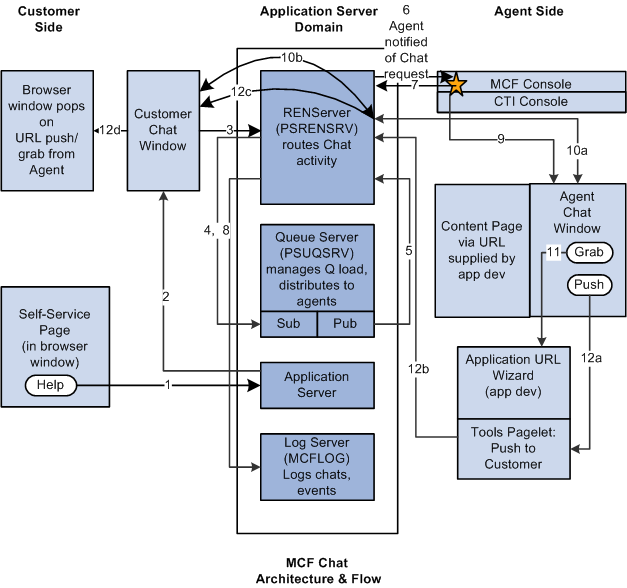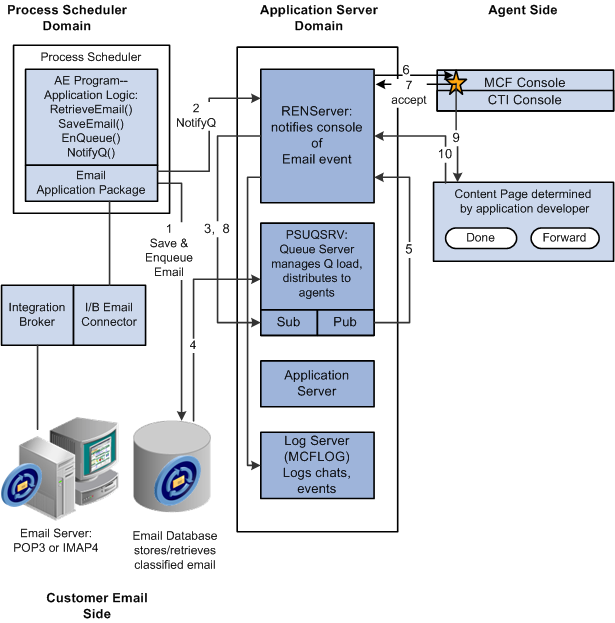 PeopleSoft MultiChannel Framework
PeopleSoft MultiChannel Framework
This chapter discusses:
PeopleSoft MultiChannel Framework.
PeopleSoft MultiChannel Framework elements and channels.
PeopleSoft MultiChannel Framework architecture.
 PeopleSoft MultiChannel Framework
PeopleSoft MultiChannel Framework
PeopleSoft MultiChannel Framework delivers an integrated infrastructure to support multiple interaction channels for call center agents or other PeopleSoft users who must respond to incoming requests and notifications on these channels.
PeopleSoft MultiChannel Framework can be used from any PeopleSoft application.
In this context, the word channel refers to the technology used to communicate during an interaction. PeopleSoft MultiChannel Framework supports the following channels:
Voice (telephone).
Web collaboration (chat).
Email.
Generic tasks.
Instant messaging.
The PeopleSoft MultiChannel Framework includes an HTML agent console, universal queueing, real-time task routing, customer-to-agent and collaborative chat, and centralized event logging.
 PeopleSoft MultiChannel Framework Elements and Channels
PeopleSoft MultiChannel Framework Elements and Channels
This section discusses:
PeopleSoft MultiChannel Framework elements.
PeopleSoft MultiChannel Framework channels.
PeopleSoft MultiChannel Framework universal queue.
PeopleSoft MultiChannel Console.

 PeopleSoft MultiChannel Framework Elements
PeopleSoft MultiChannel Framework ElementsPeopleSoft MultiChannel Framework comprises the following services and elements:
Universal queue server, running on the Universal Queue server process (PSUQSRV).
Real-time event notification (REN) server, running on the REN server process (PSRENSRV).
MultiChannel Framework (MCF) log server, running on the MCFLOG server process (PSMCFLOG).
MultiChannel console, the HTML interface through which users manage the channel interactions assigned to them.
Chat windows, the HTML interfaces used for customer-to-agent and collaborative chat sessions.
Agents, identified by their expertise and responsibilities.
PeopleCode built-in functions and an email application package.
GETMAILTARGET connector running under PeopleSoft Integration Broker.
PeopleSoft MultiChannel Application Programming Interface (PSMCAPI) to enable server-side computer-telephony integration (CTI) integration.
JavaScript MultiChannel Application Programming Interface (JSMCAPI) to enable a customizable CTI console and monitoring functions.
Each of these services and elements requires configuration.
In addition, each communication channel handled by PeopleSoft MultiChannel Framework requires supporting elements:
CTI middleware to notify the system of telephone calls.
An email server to store and serve email.
Application pages to request customer-to-agent chat sessions and to provide context data and resolution logic for all interactions.
Application pages or batch processes to enqueue generic events.

 PeopleSoft MultiChannel Framework Channels
PeopleSoft MultiChannel Framework ChannelsThis section discusses support for communications channels offered by PeopleSoft MCF.
The agent console offers a softphone and full CTI support with Oracle-validated third-party CTI systems. Relevant application pages appear based on data attached to the call by the Interactive Voice Response (IVR) and CTI middleware.
PeopleSoft application pages can include Live Help buttons that initiate customer-to-agent chat sessions. The customer and agent chat windows are browser-based and do not require a client installation or applet download. The universal queue routes chat requests to the first available agent with the skills required to handle that request. The agent chat window displays relevant customer information and enables the agent to push web content to the customer. The agent can manage multiple chat sessions from the agent console.
Agents can also include peers and supervisors in chat conferences and transfer chat sessions to other agents or queues. Agents can also initiate collaborative chats with other agents on their buddy lists.
PeopleSoft MCF enables applications to fetch Multipart Internet Mail Extensions emails from Post Office Protocol 3 (POP3) and Internet Message Access Protocol 4 (IMAP4) mail servers, store their parts in a database, and route the email to call center agents by either adding the email to worklists or enqueueing them on the universal queue. Large emails and binary attachments are not inserted into the database, but are instead stored in an attachment repository, accessible by URLs from a browser. The repository checks user-based and role-based security before retrieving an attachment. The email framework is built on PeopleSoft Integration Broker technology.
PeopleSoft MCF supports emails conforming to the Simple Mail Transfer Protocol (SMTP) specifications including both inbound and outbound HTML email.
Channels that are not provided by PeopleSoft MCF can be integrated by means of the generic channel to enqueue tasks onto the universal queue.
PeopleSoft MCF enables you to use instant messaging called from an application page by using one of several instant messaging clients, such as AOL, Yahoo, or Sametime.

 PeopleSoft MultiChannel Framework Universal Queue
PeopleSoft MultiChannel Framework Universal Queue
The universal queue accepts, evaluates, and distributes incoming task requests from multiple communication channels: email, web chat, and generic notifications.
The universal queue handles email, chat, and generic tasks. It distributes workload across the call center, or any other pool of qualified users, based on the priority of the task and the availability of agents possessing the required skill level and language skills. Availability is based on agent presence and the cost of the new task (a measure of the task's impact on agent capacity) against the current workload of each agent.
Agents can forward tasks to other agents or to another queue. The task is removed from the transferring agent's workload and added to the accepting agent's workload.
Email and generic tasks that are not closed before the agent signs out persist in the database. Persisted tasks are reassigned to the same agent that accepted the tasks when the agent signs in again. A task that is not accepted, within configurable time limits, by the agent to whom it was assigned is reassigned to another qualified agent, if one is available. Tasks that are not resolved within configurable time limits are automatically escalated. Tasks that cannot be assigned to or are not accepted by any agent within configurable time limits are moved to an overflow table.
Voice tasks (CTI) are not queued or routed by the universal queue. They take precedence over all other tasks. However, the queue server adds the cost of voice tasks to the agent workload calculations it uses to queue and assign incoming tasks.

 PeopleSoft MultiChannel Console
PeopleSoft MultiChannel Console
The agent console is the web-browser-based desktop from which the user manages all tasks, irrespective of channel. The console combines CTI, chat, email, and generic notice response tools into one configurable window. Agents use the console to sign in, to select their current queue, to accept tasks, and to initiate and accept collaborative chat requests with buddy users. After the agent accepts a task, additional browser-based windows appear to enable the agent's response. These windows are task-dependent and include elements developed specifically for supporting applications, such as email response management systems.
A custom CTI console can be created by means of the JSMCAPI.
 PeopleSoft MCF Architecture
PeopleSoft MCF ArchitectureThis section discusses:
PeopleSoft MCF server architecture.
Chat architecture.
Email architecture.

 PeopleSoft MCF Server Architecture
PeopleSoft MCF Server Architecture
The REN server (the PSRENSRV process) is essential to the framework architecture. MCF events are sent to REN servers, which then deliver them to recipients of those topics. The REN server is a modified web server using the HTTP 1.0 or HTTP 1.1 communications protocol. Communication with server processes and MCF browser windows is bidirectional, because the browser windows maintain persistent connections to the REN server. Events can be sent proactively to browser windows without polling or page refreshes. To provide a secure channel of communication to overcome concerns from PeopleSoft customers about sensitive data and its security, the REN server can be Secure Sockets Layer (SSL)-enabled. An SSL-enabled REN server provides secure communication that encrypts and provides client and server authentication.
Applications send interaction and action requests (tasks) received from the supported communication channels to logical queues. The REN server notifies the universal queue server (the PSUQSRV process) responsible for that queue that a new task has arrived. Tasks are queued in order of priority until they can be assigned to an available agent qualified to respond to the task, at which time the queue server sends an assignment notification to the user’s MultiChannel Console through the REN server.
The queue server routes work requests (tasks) to users based upon a set of configurable policy properties that define which agents can handle what types of tasks and when the tasks can be assigned. The queue server manages state information about the current status of active agents and active tasks.
The MCF log server logs MCF events and chat content to the database. You configure logging levels on the MCF administration pages.

 Chat Architecture
Chat Architecture
This diagram illustrates the architecture of a chat session:

MCF chat architecture and flow
When a customer clicks the Help button on an application page:
InitChat() passes the following parameters to the application server:
Queue number.
Priority override.
Context page URL.
Query.
The application server posts to the REN server to notify the queue server that a customer chat is waiting.
The application server then returns the name and port of the REN server and the iScript to build the customer chat window.
The customer chat window appears and communicates with the REN server to receive all events on that chat topic.
The REN server notifies the queue server that a customer chat is waiting.
The queue server determines the appropriate agent according to workload, cost, agent availability, skill level, and language.
The queue server tells the REN server to notify the agent that the agent has been assigned a chat.
The REN server notifies the agent from the MultiChannel Console that the agent has been assigned a chat.
The agent, from the MultiChannel Console, notifies the REN server to notify the queue server that the agent has accepted the task.
The REN server notifies the queue that the agent has accepted the task.
The MultiChannel Console displays an agent chat window.
The agent responds to inquiry.
Agent to customer two-way communication is mediated by the REN server.
If the agent chooses to grab a URL, the Grab button invokes the application URL wizard.
If the agent chooses to push a URL, the Push button invokes a pagelet (labeled with an A in the diagram) to push a selected URL through the REN server (labeled with a B in the diagram) and customer chat window (labeled with a C in the diagram) to a new browser window.
The entire chat session can be logged through the MCF log server (labeled with a dotted line in the preceding diagram).

 Email Architecture
Email Architecture
This diagram illustrates the architecture of email processing:

MCF email architecture and flow
When a customer sends an email:
A PeopleSoft Application Engine program uses the MCF email application package classes and PeopleCode built-in functions to save and enqueue email in a database.
The PeopleSoft Application Engine program notifies the REN server that email has been enqueued.
The REN server notifies the queue server of the waiting email.
The queue server retrieves email information required to determine appropriate routing from the database.
The queue server determines the appropriate agent to handle each email according to workload, cost, agent availability, skill level, and language.
The queue server tells the REN server to notify the agent that the agent has been assigned an email.
The REN server notifies the agent from the MultiChannel Console that the agent has been assigned an email.
The agent, from the MultiChannel Console, notifies the REN server to notify the queue server that the agent has accepted the task.
The REN server notifies the queue that the agent has accepted the task.
The MultiChannel Console displays an agent email window, as determined by the application developer.
The agent responds to the email.
The agent's resolution of the task is communicated back to the REN server by either the Done or Forward button.
Email events can be logged to a database by the MCF log server.